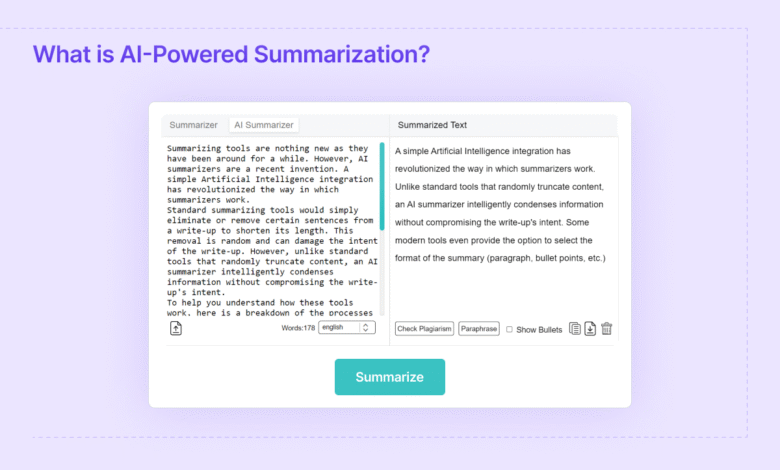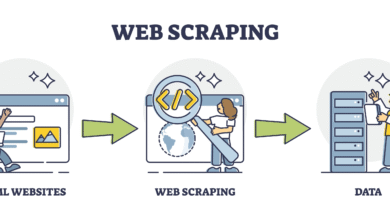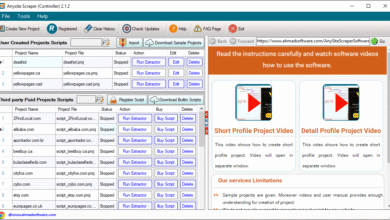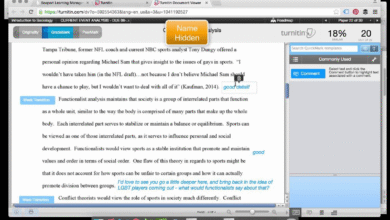Content Summarization: Techniques for Efficient Writing

Content summarization is an essential skill in today’s digital landscape, enabling readers to quickly grasp key information without the need to wade through extensive texts. By utilizing various information summarization techniques, individuals and businesses alike can effectively condense articles and reports into digestible formats. This not only enhances user experience but also boosts engagement, making content more accessible. Moreover, the rise of advanced technology has led to the development of some of the best content summarization tools available, which automate the process and improve efficiency. Understanding content extraction methods can further refine how we approach summarizing articles, ensuring that the most crucial points are highlighted.
In the realm of digital communication, condensing large volumes of text into brief, coherent versions is crucial. This process, often described as distillation of information, involves transforming lengthy documents into succinct summaries that retain their original meaning. Effective techniques for information reduction play a pivotal role in enhancing comprehension and retention. With a variety of available solutions, including advanced summarizing software and strategies, individuals can optimize the way they consume digital content. Embracing these innovations not only simplifies the digesting of complex materials but also streamlines workflows in professional settings.
Understanding Content Summarization Techniques
Content summarization is a critical process that condenses larger pieces of information into concise, manageable summaries. This technique is widely utilized across various fields—such as journalism, research, and business—where there is a constant influx of data to process. By employing effective information summarization techniques, individuals and organizations can enhance their ability to comprehend and communicate key messages. The primary goal is to retain the essential ideas while eliminating unnecessary details, ensuring that the core message is delivered clearly.
Information summarization techniques can broadly be categorized into extractive and abstractive methods. Extractive summarization involves identifying and pulling together key sentences or phrases from the original text based on their significance. Contrarily, abstractive summarization generates new sentences that paraphrase the main points of the source material, often resulting in a more coherent narrative. Understanding these distinctions is vital for selecting the appropriate technique depending on the context and audience needs.
Best Content Summarization Tools to Enhance Efficiency
In the digital age, several best content summarization tools have emerged, designed to streamline the summarization process and improve productivity. Tools like QuillBot and SMMRY leverage AI technology to offer quick and efficient excerpts from lengthy articles and documents. These tools can significantly minimize the time spent on reading and allow users to focus on decision-making or further research. The optimal choice of tool can depend on factors such as user interface preference, the complexity of the text, and the desired length of the summary.
Moreover, content extraction methods employed by these summarization tools vary, enhancing their utility across different applications. For instance, some tools provide customizable options that allow users to determine the summary’s length, while others may utilize advanced algorithms to ensure the summaries reflect the original tone and intent of the source material. As such, choosing a tool that aligns with specific summarization goals can lead to improved outcomes and better management of information overload.
The Process of Summarizing Articles Effectively
Summarizing articles effectively is an essential skill, especially for professionals who need to digest extensive literature quickly. The first step in the process is to read the article thoroughly to comprehend its main ideas and arguments. This involves identifying the thesis statement, major points, and supporting evidence before attempting to condense them into a summary. For effective summarization, it is crucial to distinguish between critical information and superfluous details that may not contribute to the overall understanding of the subject.
Once the key points are identified, the next step is to rewrite them in your own words, ensuring that the summary captures the essence of the original content without plagiarizing. This can include rephrasing sentences, integrating keywords that highlight the article’s subject, and formulating a coherent narrative that communicates the intended message clearly. By mastering this process, individuals can enhance their writing skills, contribute to better knowledge sharing, and improve their ability to interpret complex information efficiently.
Content Extraction Methods in Summarization
Content extraction methods play a pivotal role in the summarization process by identifying key elements within larger datasets or texts. These methods utilize algorithms to scan, select, and collect significant information, creating a synopsis that maintains the original context of the information provided. Key techniques often include keyword extraction, sentence ranking, and topic modeling, which aid in determining which parts of the text hold the most value for summarization.
Through the use of content extraction methods, tools can effectively condense articles while preserving critical insights and original intent. This approach is particularly beneficial in environments where large volumes of information must be processed quickly, such as news agencies or academic research. Implementing efficient extraction techniques not only saves time but also enhances the quality of summaries produced, allowing users to make well-informed decisions based on the extracted content.
Leveraging Latent Semantic Indexing for Summarization
Latent Semantic Indexing (LSI) enables a more profound understanding of content by analyzing the relationships between terms and concepts. This technique is especially advantageous in content summarization, as it aids tools in discerning the semantic meaning within texts. By employing LSI, summarization tools can generate outputs that not only capture individual keywords but also reflect the broader themes and related ideas, making the summary richer and more informative.
Furthermore, leveraging LSI in summarization processes leads to the enhancement of keyword recognition within articles, ensuring that summaries include relevant phrases that resonate well with search queries. This optimization not only benefits readers seeking concise content but also improves the article’s visibility in search engine results. Thus, the integration of LSI within content summarization practices represents an evolution in how information is managed and communicated.
Challenges in Content Summarization
Despite the advancements in content summarization tools and techniques, several challenges remain. One significant issue is maintaining accuracy versus brevity; balancing the need for a concise summary while ensuring that key details are not omitted can be daunting. Summarization tools often struggle with nuanced language, context-specific terms, or dense jargon, which may lead to misconceptions or incomplete representations of the source material.
Moreover, the diversity of text types—from academic papers to social media posts—requires flexibility in summarization approaches. Technique effectiveness varies widely based on the complexity of the text and the target audience’s prior knowledge. Hence, continuous development of more sophisticated algorithms and user-friendly features in content summarization tools is crucial for overcoming these challenges and enhancing overall information dissemination.
Creating Effective Summaries for Business Content
In business environments, effective summarization of reports, proposals, and presentations is essential for informed decision-making. Summaries should focus on executive insights and actionable recommendations while stripping away unnecessary details. This can help stakeholders grasp the relevant information quickly, fostering a culture of efficiency and clarity.
To create impactful business summaries, professionals should adopt structure and organization that prioritize critical points. Utilizing bullet points and clear headings allows for easier scanning of information, enabling busy executives to capture relevant data quickly. By cultivating summarization skills tailored for business contexts, professionals can enhance productivity and communication within their teams.
The Role of Summarization in Education
In the educational sector, summarization plays a vital role in enhancing comprehension and retention among students. By summarizing readings and lectures, students can distill complex information into manageable chunks, making it easier to study and recall crucial concepts. This active engagement with content encourages deeper learning and better academic performance.
Additionally, educators can incorporate summarization techniques into their teaching strategies, helping students develop critical thinking skills. Assigning summary tasks prompts students to analyze material, evaluate significance, and articulate their understanding in concise forms. Thus, fostering summarization skills not only contributes to individual student success but also enhances overall classroom dynamics.
Future Trends in Content Summarization Technologies
The future of content summarization technologies is poised for significant advancements driven by artificial intelligence and machine learning. As these technologies evolve, we can expect increased accuracy and context-awareness in summarization outputs, making tools more capable of performing abstractive summarization effectively. Innovations such as AI chatbots and natural language processing will likely lead to dynamic summarization algorithms that adapt to different content forms and audiences.
Moreover, as the demand for quick knowledge consumption rises, we can anticipate the development of tools designed specifically for niche markets, offering tailored summarization services that address unique informational needs. These trends indicate a shift towards more intelligent, user-centered summarization solutions, paving the way for enhanced productivity and information governance in various sectors.
Frequently Asked Questions
What are the best content summarization tools available?
There are several excellent content summarization tools that can help you condense information quickly. Some of the best options include AI-based tools like QuillBot, SMMRY, and Resoomer, which utilize advanced algorithms to perform effective website content summarization and enhance your productivity.
What are the different information summarization techniques?
Information summarization techniques vary from extractive approaches, which select key sentences from the original text, to abstractive methods that generate new text paraphrasing the main ideas. Both methods are essential in the field of content summarization, aiming to capture the essence of the source material.
How can I effectively summarize articles for my research?
To effectively summarize articles, start by identifying the main points, arguments, and findings. Use information summarization techniques like note-taking and outlining to distill these elements. Additionally, consider employing content extraction methods to ensure accuracy and relevance in your summary.
What is website content summarization and why is it important?
Website content summarization involves distilling the essential points from web pages, making information easier to digest. It’s important for improving content readability, aiding user engagement, and enhancing SEO by providing concise information snippets that attract search engine traffic.
Can content summarization tools help improve SEO?
Yes, content summarization tools can significantly improve SEO. By generating concise summaries for blog posts or articles, they create keyword-rich snippets that help search engines understand the content better, potentially leading to higher rankings and better user engagement.
| Key Point | Explanation |
|---|---|
| Limited Access to External Websites | The assistant cannot retrieve or scrape data from websites such as nytimes.com. |
| Focus on Summarization | Help is available for summarizing content that is publicly accessible. |
| User Guidance | Users are encouraged to specify the type of information or details they seek. |
Summary
Content summarization means providing a concise overview of a larger piece of information, conveying key points clearly. In this context, the assistant highlights its limitations regarding accessing content from external websites like nytimes.com, while emphasizing its capability to assist in summarizing publicly available data. Users are invited to state their specific inquiries to receive tailored help.




